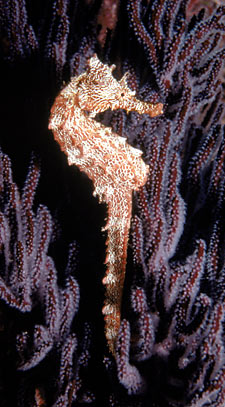![[Ocean Oasis Field Guide]](images/bnr-oo-field.gif)

![[Ocean Oasis Field Guide]](images/bnr-oo-field.gif) |  |
|
Hippocampus ingens Family: SYNGNATHIDAE 
The scientific name is derived from the Greek hippos, "horse", and campus, "sea monster." DescriptionSeahorses have a horse-shaped head and a body and tail which is covered with concentric bony rings. Their colors are variable including black, gray, brown, red, and yellow, and match their surroundings. The Pacific seahorse, when found in San Diego Bay, is generally yellowish. Size: The largest of the 32 known species of seahorses in the world, the Pacific seahorse can grow to 30 cm (1 foot) in length. Range and HabitatSeahorses are found in shallow temperate and tropical waters, around shallow reefs, seagrasses, and mangroves, using its prehensile tail to cling on plants, corals, gorgonians, or sponges. Their range extends from San Diego, California, south to Peru—including the Gulf of California. Natural HistoryThough their unusual shape makes it hard to believe, seahorses are indeed fish. In seahorses, the female uses her ovipositor to deposit her eggs in the male's brood pouch where they are fertilized and remain until hatched. After a period of time, varying from ten days to six weeks, depending on the species and water temperature, the male gives birth to hundreds of live, tiny, seahorses, which are miniature replicas of the adults. Seahorses feed on bottom-swarming organisms, such as mysids and other plankton; lacking teeth and stomachs, they suck the individually selected food through their bony snout with a very rapid snap of the head. Conservation StatusSeahorses are in constant risk from overfishing and habitat destruction. Seahorses are exploited for traditional medicines and as aquarium fishes, and their habitats are among the most threatened marine environments. According to Project Seahorse of McGill University in Montreal, in the last five years many seahorse populations have declined by 50 percent. See also Seahorse and Sea Dragon Central, a guide and web directory to these animals. |
Text by Patricia Beller
Photograph © Bob Cranston
Field Guide |
Site Index |
Ocean Oasis Introduction
|
|
© 2000 San Diego Natural History Museum |